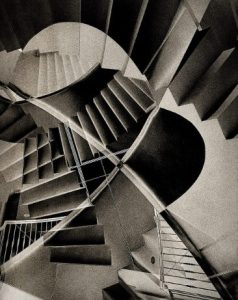Please scroll down for English
גיא ברילר /ירושלים יקירתי עבודות 1998-2014
“ירושלים יקירתי”, תערוכתו של גיא ברילר, מוצגת בבית הגפן בחיפה, מאותם איים בהם ישראל משתקפת כפי שהייתי רוצה לראות אותה: רב תרבותית, סובלנית, נבונה. התערוכה שאצרה יעלה חזות מציגה מחולקת לשתי קומות החלל המאתגר. הקומה התחתונה מוקדשת לעבודות של ברילר בירושלים שחלקן הגדול נערכו כמסעות בעיר, במרכזי השלטון המרוכזים בה ותוך התייחסות ללוח השנה היהודי ולאירועים היסטוריים קרובים ובמיוחד כיבוש/אחוד העיר ב 1967.
בקומה העליונה מוצג “כמה עדויות לחייו הקצרים ומותו של אלטרJ בג’רולין”, פרויקט שהחל 2012 וביקורת זו מתרכזת בו.

Alter Joker, 2014, silkscreen print and ink on paper, 70×50 cm
דרך הדפסים, עבודות וידיאו וצילומים ברילר מתבונן בקשר הגורדי היהודי- גרמני והישראלי-גרמני. הוא עושה זאת באופן שונה ממה שנעשה כאן בעבר למשל מעבודות שהוצגו באסופת התערוכות “בחזרה לברלין” במוזיאון הרצליה בסוף 2014. אם האמנים שם עסקו ביחס לעבר הנאצי של ברלין מהיבט של אבסורד והכרה בזמן שחלף ובשינוי הגרמני הרי ברילר מדבר על טווח היסטורי ועל מקום רעיוני רחב ועמוק יותר מזה שהחל ב 1933. הוא נוגע בהיבטים אפלים של עבר והווה, מעלה באוב את פרויקט הארכאדות של וולטר בנימין (שנכתב על פריז אך דיבר על עירוניות ועל שיטוט בכלל), את האלטרנטיבות הקומוניסטיות שלא צלחו בגרמניה של שנות ה 20, לצד יצירת ישות אוטופית- דיסטופית “ג’רולין” שמאחדת את ירושלים וברלין.
הקשר בין הערים, בין יהודים וגרמניה, נע בין מישורים דתיים מיסטיים למישורים קונקרטיים. ירושלים כרעיון, ירושלים השמימית, נכחה בנוף הברלינאי כבר מאז המאה ה16 עם כנסיה שנקראה “כנסיית ירושלים” שהתפרסמה בזכות העתק מוקטן של כנסיית הקבר שהוחזק בה. במה ה 18 נקרא הרחוב לידה רחוב ירושלים. בסדרת צילומים ברליר מציג את כנסיית הקבר ליד בור ברחוב פרידריכשטראסה בברלין, ואפשר לחשוב על הקבר והבור כשני צידי של מעמקים – הבור עם הרמיזה לשרשרת האסוציאציות שמבורות מים- מקוואות- היטהרות וגם כקבר, המקבר הקדוש ועד לאין ספור אתרי הקבורה, הרצח, שמנקדים את ברלין.
שוב ושוב עולה על הדעת המונח chronotope שטבע הפילוסוף הרוסי מיכאל בחטין בהקשר של ספרות. המונח המורכב מהמילים זמן וחלל, יחסים מדבר על האופן בו חלל נטען במימד של היסטוריה עד שהם נטמעים.

Two Bismarcks six stars, 2014, silkscreen print and ink on canvas, 107×150 cm
הדמות של אלטר ג’וקר, היא דיוקנו של ברילר כג’וקר שקיבל אפיונים של האויב המושבע של באטמן שהומצא ב 1940, כלומר בראשית מלחמת העולם השנייה. על מצחו J כמו האות הראשונה של המילה “יהודי” בגרמנית שהוטבעה על כל מסמך של יהודים אחרי עליית הנאצים לשלטון. הדמות הזו מוצגת בחלל צדדי בתערוכה, אחרי שהצופה רואה את החלל המרכזי ובו דיוקן כפולי של ביסמרק ליד דיוקן הרצל בו מופיע הכיתוב “החלום אינו כה שונה מהמציאות כפי שאנשים מאמינים”. הקשר בין האישים שחיו במקביל היה חד צדדי: הרצל העריץ את ביסמרק שהוביל את איחוד גרמניה (וכפי הנראה גם כתב לו אודות הציונות). המערבולת ההיסטורית הופכת לסחרחורת: ברילר יצר היסט של ההדפס המפורסם של וורהול בו נראה אלביס פרסלי מוכפל ׁ(כנראה מפרסומת הסרט Flaming Star 1960) . על פניו של הזמר וסמל הסקס היא מרכיב מסכה שעליה הכיתוב אלטרJ .המסכה הנראית ספק מסכת מגן, ספק מצנפת אינקויזטור מימי הביניים או גלגול כיסוי ראש של קולקלס- קלאן מורכבת גם על פניהן של שתי דמויות זהות על גג כאשר אחד עומד לערוף את ראש הדמות השניה. ההתייחסות לתמונות הזוועה של עריפות הראשים של דאעש, מה שהפך לאיום על הסדר כפי שאנו מכירים כיום ברור. הכפילויות של דיוקנאות ודימויים: ביסמרק, אלויס- אלטרJ , הרייכסטאג או דימוי בשם “צבי” מסמנים כולם אמביוולנטיות שהופכת מעיקה יותר ויותר.

Six Alter, 2014, silkscreen print and ink on canvas, 107×150 cm
במרכז החלל מבנה מתכת שנבנה כ“ארון ברית” ושימש בפרויקטים של הליכה שעשה ברילר בירושלים . הארון הסימבולי, שמתייחס לארון הברית שאיתו נדדו בני ישראל במדבר,והושם לבסוף במקדש מונח בחלל כאילו נדד שוב והפעם הוא ב”ג’רולין” , שוב ללא מקדש.
שתי עבודות הוידיאו בחלק זה בתערוכה צולמו באנדרטה לשואה של פיטר אייזנמן. ברילר הקרין עליה דימויים של ירושלים בעבודה בשם Kleiner Krug, 2013 (כד קטן) ובעבודה חדשה המוסיקאי גדי רונן שר שיר על אחריות לזיכרון ישוב על אחד ממלבני הבטון. בעשור מאז נחנכה האנדרטה הפכה לנקודת ציון מרכזית בברלין, אתר תיירות וגם מגרש משחקים מועדף על ילדי העיר. היא כמעט מגלמת את האופן הבלתי צפוי בו זיכרון פועל.
הדרכון של “ג’רולין” משלב את סמל האריה של ירושלים והדוב של ברלין, ורוד כמו הטלאי של הומוסקסואלים בגרמניה הנאצית. ברילר הזמין אמנים לתוכנית שהיה בשגרירות הבדויה של גרולין ועבודות שיצרו או שיצר איתם כמו (שניים) רפרם מחכה ללנין – אנדרטת ליבקנכט, פוסטדאמר-פלאץ, 2014, שיצר עם רפרם חדד מרחיבות את היריעה.

במזרח ברלין לשעבר,באתר שהוא חגיגה של צרכנות ומותגים מחכה אמן ישראלי (שהיה עצור כמרגל בכלא בלוב) למנהיג קומוניסטי, נשען על מצבתו המפויחת של מרטיר הקומוניזם הגרמני שנרצח ב 1919 בידי לאומניים גרמנים: שוב הכפלה ואמביוולנטיות,קשה לחשוב על מערך טרוף יותר של עבר והווה.
אוצרת: יעלה חזות
בית הגפן מרכז תרבות ערבי יהודי, רחוב הגפן 2, חיפה טל’ 04-8525252
ראשון עד חמישי: 10:00-15:00 שישי, שבת: 10:00-14:00
הרשמה לניוזלטר הפירסומי השבועי של “החלון” בנושאי אמנות, אירועים ותערוכות חדשות – www.smadarsheffi.com/?p=925 (הרישום נפרד מהרישום לבלוג )
הערות/הארות אנא כיתבו ל thewindowartsite@gmail.com
Guy Briller/Dear Jerusalem Works 1998-2014
Dear Jerusalem, Guy Briller’s solo exhibition at Beit Hagefen, Haifa, is one of those “islands” in which Israel is reflected as I would have loved to see it: multicultural, tolerant, and wise. The exhibition, curated by Yeala Hazut, is presented on two floors of the challenging space. The lower floor is devoted to Briller’s works from Jerusalem, the majority of which are journeys through the city and its centers of government, while referring to the Hebrew calendar and recent historical events, especially to the unification of Jerusalem/conquest of Jerusalem in 1967.
The upper floor is the site of Several testimonies on the short life and death of Alter J in Jerulin, a project Briller began in 2012, on which this critique concentrates.

Herzel Black, 2014, silkscreen print and ink on paper, 150×107 cm
Briller observes the inextricably connected Jewish-German and Israeli-German relationship through silkscreen prints, videos and photographs, in a way that is entirely different from what has been done here in the past, and which stands out from works exhibited in the group of exhibitions in the International Back to Berlin Project at the Herzliya Museum of Contemporary Art in late 2014. If the artists engaged in Berlin’s Nazi past from an absurdist point of view, recognizing that time has past and change has occurred in Germany, Briller speaks of the historical range and a philosophical place which is broader and deeper than the one that began in 1933. He touches upon dark places of past and present, calling up Walter Benjamin’s Arcades Project (written about Paris, but which discussed urbanism and the flaneur in general), the Communist alternatives of 1920s Germany, while inserting images made up of symbols from Jerusalem along with the creation of “Jerulin,” a utopian-dystopia unifying Jerusalem and Berlin.
The combination of the two cities and two peoples moves between mystical religious planes and concrete levels – Jerusalem as an idea, Heavenly Jerusalem, was present in the Berlin landscape since the 16th century with the Jerusalem Church with its reduced copy of the Holy Sepulcher. In the 18th century, the street nearby was named Jerusalemstrasse. Briler made a series of photographs in which the Church of the Holy Sepulcher is adjacent to a pit on Friedrichstrasse in Berlin, as if the Holy Sepulchre and the hole are two sides of the depths. The juxtaposition hints at associations with water cisterns, ritual baths (mikvehs), purification and burial sites, from the Holy Sepulcher to countless graves marking Berlin, and the memory of genocide.

Reichstag 1945, 2014, silkscreen print and ink on paper, 100×70 cm
The word “chronotype” is the unavoidable association, a concept coined by Russian philosopher Mikhail Bakhtin in the context of literature, referring to the way in which a space is charged with history and assimilates it.
Alter J (2014) is Briller’s portrait as a Joker, merging with Batman’s arch-enemy the Joker created in 1940, at the beginning of World War II. The Joker’s forehead is stamped with a J, as were Jews’ documents when the Nazis took power. This piece is exhibited in a side hall, after the viewer sees the main hall in which a portrait of Two Bismarcks is hung near a portrait of Theodor Herzl with the caption, “The dream is not as different from reality as people believe.” Herzl admired Bismarck, the chancellor who unified Germany (and apparently wrote him about Zionism). Briller’s use of historical images becomes dizzying: he seems to have based his print Alter J on Warhol’s print of Elvis doubled (apparently from a poster advertising the film “Flaming Star” (1960). The mask over the face inscribed Alter J could be a gas mask, inquisitor’s hood or a KKK hood, also appears on two identical figures on the roof, with one ready to behead the second, reminding us of horrific ISIS images. The doubled images give a feeling of ambivalence, which becomes increasingly oppressive.

At the center of the space stands the metal “Holy Ark,” used in Briller’s journeys to and within Jerusalem. The symbolic Ark, referring to the biblical Holy Ark the Israelites carried through the desert and finally placed in the Temple, is also carried on wandering journeys in “Jerulin,” without a Temple to rest in.
The two video works in this section of the exhibition were filmed at the Berlin Holocaust Memorial designed by Peter Eisenman. Briller projected images of Jerusalem in Kleiner Krug (2013) [Little Jug], while in his newer work, musician Gedy Ronen sings a song on the responsibility to memory while sitting on one of the concrete slabs making up the monument. Over the past decade, the monument has become a major landmark in Berlin, a tourist site and favorite children’s playground. It is a nearly perfect illustration of the unexpected workings of memory.
The “Jerulin passport” combines the lion symbol of Jerusalem with Berlin’s bear, and is pink like the patch homosexuals were forced to wear in Nazi Germany. Briller invited artists to join a residency program at the fictional Embassy of Jerulin, which generated (collaborative) works such as Double Rafram is Waiting for Lenin – Liebknecht Monument, Postdamer Platz (2014), a digital print on paper created with Rafram Hadad, and which broaden the scope.

kliner-krug-180-100-cm
In the former East Berlin, at a site of rampant consumerism and brand names, an Israeli artist (who was imprisoned as a spy in a Libyan jail) awaits a Communist leader, leaning on the sooty gravestone of a martyr of German Communism murdered in 1919 by German nationalists: once again, Briller depicts doubling and ambivalence. It is difficult to imagine a more intricate mixture of past and present.
Join the mailing list for Window’s weekly informational advertising newsletter: www.smadarsheffi.com/?p=925
Comments – please write to thewindowartsite@gmail.com







